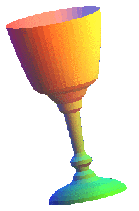- About MAA
- Membership
- MAA Publications
- Periodicals
- Blogs
- MAA Book Series
- MAA Press (an imprint of the AMS)
- MAA Notes
- MAA Reviews
- Mathematical Communication
- Information for Libraries
- Author Resources
- Advertise with MAA
- Meetings
- Competitions
- Programs
- Communities
- MAA Sections
- SIGMAA
- MAA Connect
- Students
- MAA Awards
- Awards Booklets
- Writing Awards
- Teaching Awards
- Service Awards
- Research Awards
- Lecture Awards
- Putnam Competition Individual and Team Winners
- D. E. Shaw Group AMC 8 Awards & Certificates
- Maryam Mirzakhani AMC 10 A Awards & Certificates
- Two Sigma AMC 10 B Awards & Certificates
- Jane Street AMC 12 A Awards & Certificates
- Akamai AMC 12 B Awards & Certificates
- High School Teachers
- News
You are here
Art and Design in Mathematics - Other Design Projects
We have had success at Kenyon with two other projects that I would put in the same category as the parametric plots project, because both involve significant elements of art and design and both are popular among the students.
The first project asks students to design a wineglass (i.e., a solid of revolution) subject to a list of criteria involving volume and center of mass. The second project asks students to design tiles for a swimming pool subject to various constraints dealing with the area of the region between decorative curves on the tiles.
The Goblet Project - Students are asked to design a wine goblet that meets the following mathematical specifications:
|
|
|
The goblet project has evolved into its present form after several iterations, and it was difficult for me to trace its origins. However, it appears that Mark Snavely (Carthage College) is responsible for the first iteration. During his first year of teaching at Carthage, he asked his students to design a goblet and a plate and to compute the volume of each. The project was later adapted into its present form by Carol Schumacher (Kenyon College) and Patty McKenna (Metropolitan State College).
An early version of the computer-based calculus course Calculus & Mathematica, written by Jerry Uhl, Bill Davis, and Horatio Porta, also included a problem involving the volume of a wineglass, but it appears that this was written independently and there was no element of design involved.
The Tiling Project – In Problems for Student Investigation, John Ramsay of Wooster College introduced his version of a tile design project adapted from an earlier version appearing in MAPLE: Calculus Workbook Problems and Solutions .
I adapted the project further, making it more appealing for a Kenyon student. Kenyon has a long history of success in swimming and is in the process of constructing a new Fitness and Recreation Center. My version of the tiling project asks students to design a two-colored tile and floor plan for Kenyon’s new Olympic-sized swimming pool, with the constraints that
-
each region of a tile must be simple, and
-
there may be no more than three regions per tile.
Students then employ integration to compute the percentage of tile devoted to each of the two colors.
I find this project appealing, not only because it is a nice application of integration, but also because it provides a good opportunity to discuss symmetry with the students.
Judy Holdener, "Art and Design in Mathematics - Other Design Projects," Convergence (December 2004)





